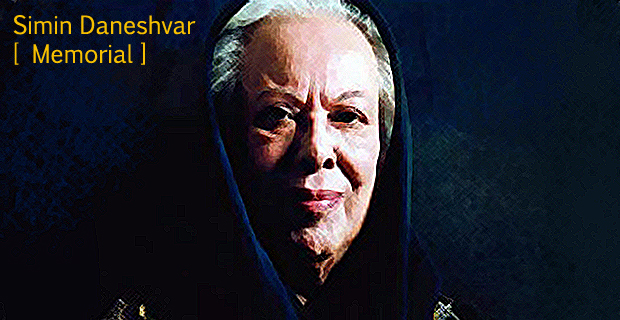
On the anniversary of the death of Simin Daneshvar (March 8, 2012)
Simin Daneshvar (1921-2012) was often compared to the Scheherazade of A Thousand and One Nights. She is Iran’s first woman short-story writer and novelist. However, her first book The Quenched Fire (1948), a collection of short stories, is far from a literary masterpiece. The stories fall short in catching the nuances of human behavior in the face of different happenstances in life. The protagonist in most of the stories is an educated, rich, pedantic and emotional young woman whom Daneshvar employed to juxtapose the Iranian patriarchal limitations with western cultural advancements. However, this early collection introduced a feminine voice into Iranian fiction that Daneshvar later developed in her novels and short stories. Throughout her literary career, Daneshvar published three more short story collections: A City Like Paradise (1961), To Whom Shall I Say Hello (1980), and Ask the Swallows (1997); and three novels: Savushun (1969),Wandering Island (1992), and Wandering Cameleer (2001).
Most of Daneshvar’s protagonists are women; her attention to women’s lives and their characters were unprecedented in the fictional literature of Iran. The women she portrayed are unalike those that her famous contemporaries Sadeq Chubak and Sadeq Hedayat portrayed in their stories. Zari, the protagonist of Savushun, is an ordinary young housewife who desires to occupy herself with the world of andaruni [1], until her husband’s martyrly death. She is not abstract, like Hedayat’s femme fatale in The Blind Owl, or miserably caught between the archetypal roles of caring mother/prostitute, like Gowhar in Chubak’s The Patient Stone. However, Daneshvar’s female characters are not very diverse; they are either rich and from the affluent class, or poor and deprived and in service to the rich.
Daneshvar’s work is not political, but this does not mean that it was not influenced by the spirit of the time; in fact, one can trace Iran’s tumultuous political history in Daneshvar’s corpus. Wandering Island and Wandering Cameleer are both set against the backdrop of Iran’s sociopolitical events that lead to the 1979 Islamic Revolution. Savushun, one of Iran’s best selling novels and arguably Daneshvar’s masterpiece, is a historical novel with a biographical tint. The novel’s setting is Fars Province in the final months of World War II; it depicts the people’s resistance towards the English forces occupying parts of Iran at the time. The tragic death of Yusof, the protagonist’s husband, for his resistance against the British, exemplifies Daneshvar’s recurrent themes of morality and patriotism. Savushun has been translated into 17 languages including twice into English. The first English translation was done by M. R. Ghanoonparvar under the title Savushun: A Novel About Modern Iran (1990), and the second one was published under the title A Persian Requiem (1992) by Roxane Zand.


Leave a Reply